The Synergy of Ventilation System Layouts and Occupant Arrangements on Ventilation Effectiveness: A Case Study in a Shared Office
Abstract
1. Introduction
2. Methods
2.1. Details of the Experimental Facility
2.2. Developing the Computational Model
2.2.1. Initial CFD Model and Validation Setup
2.2.2. Boundary Conditions
2.2.3. Computational Settings and Parameters
Meshing Scheme and Grid Independence Test
2.3. Model Validation
2.4. The Procedure for Calculating Ventilation Effectiveness
2.5. Effect of Various Layouts on Air Quality and Ventilation Effectiveness
3. Results
3.1. Impact of System Settings on Efficient Improvement of Air Quality
3.2. Impact of Occupant Seating Orientations on Efficient Improvement of Air Quality
3.3. Zonal Ventilation Effectiveness and System Performance
4. Limitations
5. Conclusions
- Airflow rate is not an indicator of air quality. A well-mixed assumption in a mixing ventilation system is not sufficient. Careful planning of occupant arrangement in relation to the system settings leads to an improved air quality and increased ventilation effectiveness. An optimally located side-to-side arrangement with respect to a supply diffuser resulted in 26.3% better air quality compared to the supply to the back arrangement.
- The number of occupants carries a significant weight in determining ventilation effectiveness. The VE is primarily influenced by occupant arrangement and density rather than supply proximity (location and flow rate). However, both variables affect VE.
- Exhaust location has a greater impact on efficient air quality improvement than ceiling height in system design. Placing the exhaust in the middle of the room (at an equal distance to all the contaminant sources) resulted in up to 10% improvement in ventilation effectiveness. Simultaneously, increasing the ceiling height by 10% improved ventilation effectiveness by 20% in a fully occupied room. This improvement yielded an 8.5% reduction in the required air change rate in the model with exhaust at the “b” axis.
- A higher ceiling height combined with a lower airflow rate can achieve nearly the same improvement in air quality as the increased airflow rate. In the same airflow rate, increasing the ceiling level improves the air quality in the breathing zone and VE by approximately 20% in a fully occupied room.
- In low-density rooms (<10 occupants), proximity to exhausts enhanced breathing zone air quality, particularly at lower ceiling heights, whereas in high-density rooms (24 occupants), the same exact positioning resulted in both lower air quality and lower ventilation effectiveness.
- Positioning a supply diffuser too close to a wall (≈0.8 m) with an occupant seated parallel to the supply diffuser at a distance of 0.5 m promoted an adverse pressure gradient, causing contaminant accumulation in the breathing zone. Maintaining a horizontal distance greater than 90 cm yielded more favorable airflow patterns and improved air quality.
- The effectiveness of mixing ventilation systems depends on how the circulation flow interacts with the thermal plume from the occupants, the thermal plume direction, and the subsidence of fresh air at BZ.
Author Contributions
Funding
Data Availability Statement
Conflicts of Interest
Nomenclature
| Symbol/Abbreviation | Definition | Unit |
| ACH | Air Changes per Hour | h−1 |
| AME | Absolute Mean Error | - |
| A | Area (inlet/exhaust) | m2 |
| BZ | Breathing Zone (typically 0.75–1.8 m above floor level) | - |
| CFD | Computational Fluid Dynamics | - |
| CO2 | Carbon dioxide (used as tracer gas/contaminant proxy) | ppm |
| h | Ceiling height | m |
| HVAC | Heating, Ventilation, and Air Conditioning | - |
| ṁ | Mass Flow Rate | kg/s |
| ppm | Parts per million | - |
| q″ | Heat Flux (surface heat transfer rate per unit area) | W/m2 |
| Q | Volumetric airflow rate | m3/s or CFM |
| T | Air temperature | °C or K |
| U | Air velocity | m/s |
| VE | Ventilation Effectiveness | - |
| η | Efficiency | - |
| ρ | Air density | kg/m3 |
| H2O (v) | Water vapor concentration | g/kg (humidity ratio) %RH |
References
- ASHRAE. ASHRAE Handbook—Fundamentals, 2017th ed.; American Society of Heating, Refrigerating and Air-Conditioning Engineers: Atlanta, GA, USA, 2017. [Google Scholar]
- Awbi, H.B.; Gan, G. Evaluation of the Overall Performance of Room Air Distribution. In Proceedings of the 6th International Conference on Indoor Air Quality and Climate, Helsinki, Finland, 4–8 July 1993. [Google Scholar]
- Sandberg, M. What Is Ventilation Efficiency? Build. Environ. 1981, 16, 123–135. [Google Scholar] [CrossRef]
- Behne, M. Indoor Air Quality in Rooms with Cooled Ceilings. Mixing Ventilation or Rather Displacement Ventilation? Energy Build. 1999, 30, 155–166. [Google Scholar] [CrossRef]
- Jameson, A.; Baker, T.J. Improvements to the Aircraft Euler Method; AIAA Aerospace Research Central: Reston, VA, USA, 2012. [Google Scholar]
- Rajashekaraiah, T.; Panigrahi, S.P.; Sanjai, G.S.; Dulabhai, H.P.; Vijaykumar, V.M. Investigating Various Meshing Techniques in Computational Fluid Dynamics (CFD) for Their Impact on Heat Transfer Parameters of Fins. J. Mines Met. Fuels 2025, 73, 117–128. [Google Scholar] [CrossRef]
- Pantelic, J. Designing for Airborne Infection Control; ASHRAE: Atlanta, GA, USA, 2019. [Google Scholar]
- Zhang, S.; Lin, Z. Dilution-Based Evaluation of Airborne Infection Risk—Thorough Expansion of Wells-Riley Model. Build. Environ. 2021, 194, 107674. [Google Scholar] [CrossRef]
- Rencken, G.K.; Rutherford, E.K.; Ghanta, N.; Kongoletos, J.; Glicksman, L. Patterns of SARS-CoV-2 Aerosol Spread in Typical Classrooms. Build. Environ. 2021, 204, 108167. [Google Scholar] [CrossRef]
- Li, W.; Chong, A.; Hasama, T.; Xu, L.; Lasternas, B.; Tham, K.W.; Lam, K.P. Effects of Ceiling Fans on Airborne Transmission in an Air-Conditioned Space. Build. Environ. 2021, 198, 107887. [Google Scholar] [CrossRef]
- Wang, F.; Permana, I.; Rakshit, D.; Prasetyo, B.Y. Investigation of Airflow Distribution and Contamination Control with Different Schemes in an Operating Room. Atmosphere 2021, 12, 1639. [Google Scholar] [CrossRef]
- Chung, K.-C.; Hsu, S.-P. Effect of Ventilation Pattern on Room Air and Contaminant Distribution. Build. Environ. 2001, 36, 989–998. [Google Scholar] [CrossRef]
- Van Hooff, T.; Blocken, B. Mixing Ventilation Driven by Two Oppositely Located Supply Jets with a Time-Periodic Supply Velocity: A Numerical Analysis Using Computational Fluid Dynamics. Indoor Built Environ. 2020, 29, 603–620. [Google Scholar] [CrossRef]
- Memarzadeh, F.; Xu, W. Role of Air Changes per Hour (ACH) in Possible Transmission of Airborne Infections. Build. Simul. 2012, 5, 15–28. [Google Scholar] [CrossRef]
- Liu, S.; Koupriyanov, M.; Paskaruk, D.; Fediuk, G.; Chen, Q. Investigation of Airborne Particle Exposure in an Office with Mixing and Displacement Ventilation. Sustain. Cities Soc. 2022, 79, 103–718. [Google Scholar] [CrossRef]
- Cao, G.; Awbi, H.; Yao, R.; Fan, Y.; Sirén, K.; Kosonen, R.; Zhang, J. A Review of the Performance of Different Ventilation and Airflow Distribution Systems in Buildings. Build. Environ. 2014, 73, 171–186. [Google Scholar] [CrossRef]
- Qin, C.; He, Y.; Li, J.; Lu, W.Z. Mitigation of Breathing Contaminants: Exhaust Location Optimization for Indoor Space with Impinging Jet Ventilation Supply. J. Build. Eng. 2023, 69, 106250. [Google Scholar] [CrossRef] [PubMed]
- Hongtao, X.; Naiping, G.; Jianlei, N. A Method to Generate Effective Cooling Load Factors for Stratified Air Distribution Systems Using a Floor-Level Air Supply. HVAC R Res. 2009, 15, 915–930. [Google Scholar] [CrossRef]
- Berlanga, F.A.; Olmedo, I.; de Adana, M.R.; Villafruela, J.M.; José, J.F.S.; Castro, F. Experimental Assessment of Different Mixing Air Ventilation Systems on Ventilation Performance and Exposure to Exhaled Contaminants in Hospital Rooms. Energy Build. 2018, 177, 207–219. [Google Scholar] [CrossRef]
- Park, J.; Lee, K.S.; Park, H. Optimized Mechanism for Fast Removal of Infectious Pathogen-Laden Aerosols in the Negative-Pressure Unit. J. Hazard. Mater. 2022, 435, 128978. [Google Scholar] [CrossRef]
- Wang, C.; Hong, J. Numerical Investigation of Airborne Transmission in Low Ceiling Rooms under Displacement Ventilation. Phys. Fluids 2023, 35, 023321. [Google Scholar] [CrossRef]
- Hunt, G.R.; Linden, P.F. Displacement and Mixing Ventilation Driven by Opposing Wind and Buoyancy. J. Fluid Mech. 2005, 527, 27–55. [Google Scholar] [CrossRef]
- Izadyar, N.; Miller, W. Ventilation Strategies and Design Impacts on Indoor Airborne Transmission: A Review. Build. Environ. 2022, 218, 109158. [Google Scholar] [CrossRef]
- Katramiz, E.; Ghaddar, N.; Ghali, K.; Al-Assaad, D.; Ghani, S. Effect of Individually Controlled Personalized Ventilation on Cross-Contamination Due to Respiratory Activities. Build. Environ. 2021, 194, 107719. [Google Scholar] [CrossRef]
- Ai, Z.; Hashimoto, K.; Melikov, A.K. Influence of Pulmonary Ventilation Rate and Breathing Cycle Period on the Risk of Cross-Infection. Indoor Air 2019, 29, 993–1004. [Google Scholar] [CrossRef] [PubMed]
- Abuimara, T.; O’Brien, W.; Gunay, B. Quantifying the Impact of Occupants’ Spatial Distributions on Office Buildings Energy and Comfort Performance. Energy Build. 2021, 233, 110695. [Google Scholar] [CrossRef]
- Bhagat, R.K.; Davies Wykes, M.S.; Dalziel, S.B.; Linden, P.F. Effects of Ventilation on the Indoor Spread of COVID-19. J. Fluid Mech. 2020, 903, F1. [Google Scholar] [CrossRef] [PubMed]
- Yamasawa, H.; Kobayashi, T.; Yamanaka, T.; Choi, N.; Cehlin, M.; Ameen, A. Effect of Supply Velocity and Heat Generation Density on Cooling and Ventilation Effectiveness in Room with Impinging Jet Ventilation System. Build. Environ. 2021, 25, 108299. [Google Scholar] [CrossRef]
- Yoo, S.J.; Ito, K. Validation, Verification, and Quality Control of Computational Fluid Dynamics Analysis for Indoor Environments Using a Computer-Simulated Person with Respiratory Tract. Jpn. Archit. Rev. 2022, 5, 714–727. [Google Scholar] [CrossRef]
- Han, M.; Ooka, R.; Kikumoto, H.; Oh, W.; Bu, Y.; Hu, S. Experimental Measurements of Airflow Features and Velocity Distribution Exhaled from Sneeze and Speech Using Particle Image Velocimetry. Build. Environ. 2021, 205, 108293. [Google Scholar] [CrossRef]
- Xu, C.; Nielsen, P.V.; Gong, G.; Liu, L.; Jensen, R.L. Measuring the Exhaled Breath of a Manikin and Human Subjects. Indoor Air 2015, 25, 188–197. [Google Scholar] [CrossRef]
- Xu, C. Characterizing Human Breathing and Its Interactions with Room Ventilation. Ph.D. Thesis, Aalborg University, Aalborg, Denmark, 2018. [Google Scholar]
- van Beest, M.R.R.S.; Arpino, F.; Hlinka, O.; Sauret, E.; van Beest, N.R.T.P.; Humphries, R.S.; Buonanno, G.; Morawska, L.; Governatori, G.; Motta, N. Influence of Indoor Airflow on Particle Spread of a Single Breath and Cough in Enclosures: Does Opening a Window Really ‘Help’? Atmos. Pollut. Res. 2022, 13, 101473. [Google Scholar] [CrossRef]
- Li, X.; Wu, Q.; Zhang, E.; Wu, Y. Analysis of Viral Aerosol Distribution Characteristics in Typical Body Positions of Patients under Local Exhaust Air. E3S Web Conf. 2024, 536, 3006. [Google Scholar] [CrossRef]
- Nielsen, P.V. Flow in Air-Conditioned Rooms: Model Experiments and Numerical Solution of the Flow Equations. Ph.D. Thesis, Technical University of Denmark, Copenhagen, Denmark, 1974. [Google Scholar]
- Menter, F.R. Two-Equation Eddy-Viscosity Turbulence Models for Engineering Applications. AIAA J. 1994, 32, 1598–1605. [Google Scholar] [CrossRef]
- Argyropoulos, C.D.; Markatos, N.C. Recent Advances on the Numerical Modelling of Turbulent Flows. Appl. Math. Model. 2015, 39, 693–732. [Google Scholar] [CrossRef]
- Gilani, S.; Montazeri, H.; Blocken, B. CFD Simulation of Stratified Indoor Environment in Displacement Ventilation: Validation and Sensitivity Analysis. Build. Environ. 2016, 95, 299–313. [Google Scholar] [CrossRef]
- ANSYS, Inc. ANSYS Fluent User’s Guide; ANSYS, Inc.: Canonsburg, PA, USA, 2023. [Google Scholar]
- Chen, Q. Comparison of Different K-ε Models for Indoor Air Flow Computations. Numer. Heat Transf. Part B Fundam. 1995, 28, 353–369. [Google Scholar] [CrossRef]
- Qin, C.; Fang, H.; Wu, S.; Lu, W. Establishing Multi-Criteria Optimization of Return Vent Height for Underfloor Air Distribution System. J. Build. Eng. 2022, 57, 104800. [Google Scholar] [CrossRef]
- Kato, S.; Murakami, E.S. New Ventilation Efficiency Scales Based on Spatial Distribution of Contaminant Concentration Aided by Numerical Simulation. ASHRAE 1988, 94, 2978. [Google Scholar]
- EN 16798-3:2017; Energy Performance of Buildings—Ventilation for Buildings—Part 3: For Non-Residential Buildings—Performance Requirements for Ventilation and Room-Conditioning Systems. CEN: Brussels, Belgium, 2017.
- Allard, F. Ventilation Effectiveness; REHVA Guidebook No. 2; Federation of European Heating, Ventilation, and Air Conditioning Associations (REHVA): Brussels, Belgium, 2002. [Google Scholar]
- ASHRAE. RP-1833: Literature Review for Evidence of the Basis for Specified Air Change Rates (ACR) for Cleanrooms, Laboratories, Laboratory Animal Facilities, and Healthcare Facilities with Medium to High ACR; ASHRAE: Atlanta, GA, USA, 2023. [Google Scholar]
- Kurnitski, J.; Kiil, M.; Mikola, A.; Võsa, K.V.; Aganovic, A.; Schild, P.; Seppänen, O. Post-COVID Ventilation Design: Infection Risk-Based Target Ventilation Rates and Point Source Ventilation Effectiveness. Energy Build. 2023, 296, 113386. [Google Scholar] [CrossRef]
- ANSI/ASHRAE Standard 62.1-2016; Ventilation for Acceptable Indoor Air Quality, 2016th ed. American Society of Heating, Refrigerating and Air-Conditioning Engineers: Atlanta, GA, USA, 2016.
- Awbi, H.B. Ventilation of Buildings, 2nd ed.; Taylor & Francis/Routledge: London, UK, 2007; Volume 536. [Google Scholar]
- ASHRAE. ASHRAE Position Document on Indoor Carbon Dioxide; ASHRAE: Atlanta, GA, USA, 2022. [Google Scholar]
- Chahardoli, S.; Lesan, M.; Bhattacharya, A. The Effects of Diffuser Location on Ventilated Airflow—A Numerical Simulation Study. ASHRAE Trans. 2024, 130, 775–783. [Google Scholar]
- Zhou, Q.; Qian, H.; Ren, H.; Li, Y.; Nielsen, P.V. The Lock-up Phenomenon of Exhaled Flow in a Stable Thermally-Stratified Indoor Environment. Build. Environ. 2017, 116, 246–256. [Google Scholar] [CrossRef]
- Romano, F.; Marocco, L.; Gustén, J.; Joppolo, C.M. Numerical and Experimental Analysis of Airborne Particles Control in an Operating Theater. Build. Environ. 2015, 89, 369–379. [Google Scholar] [CrossRef]
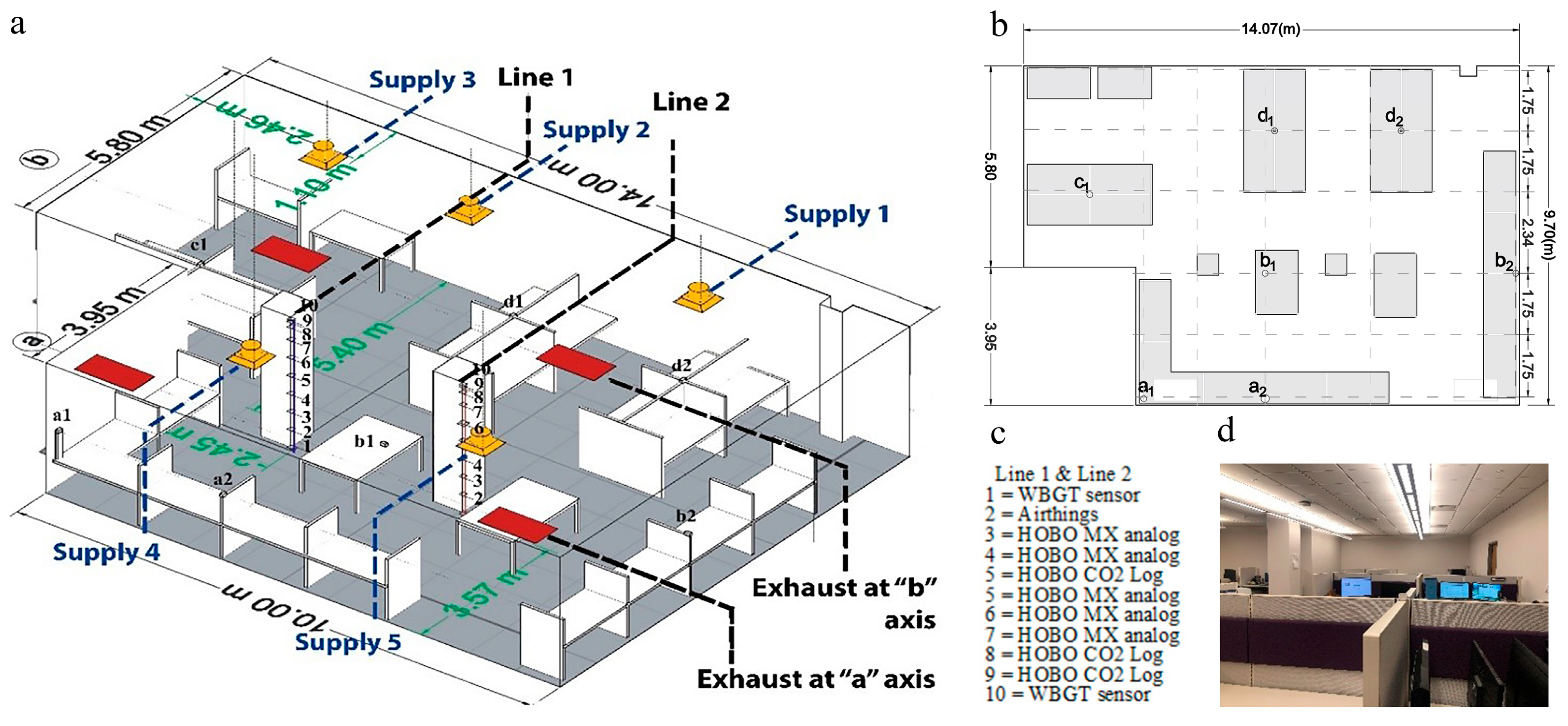
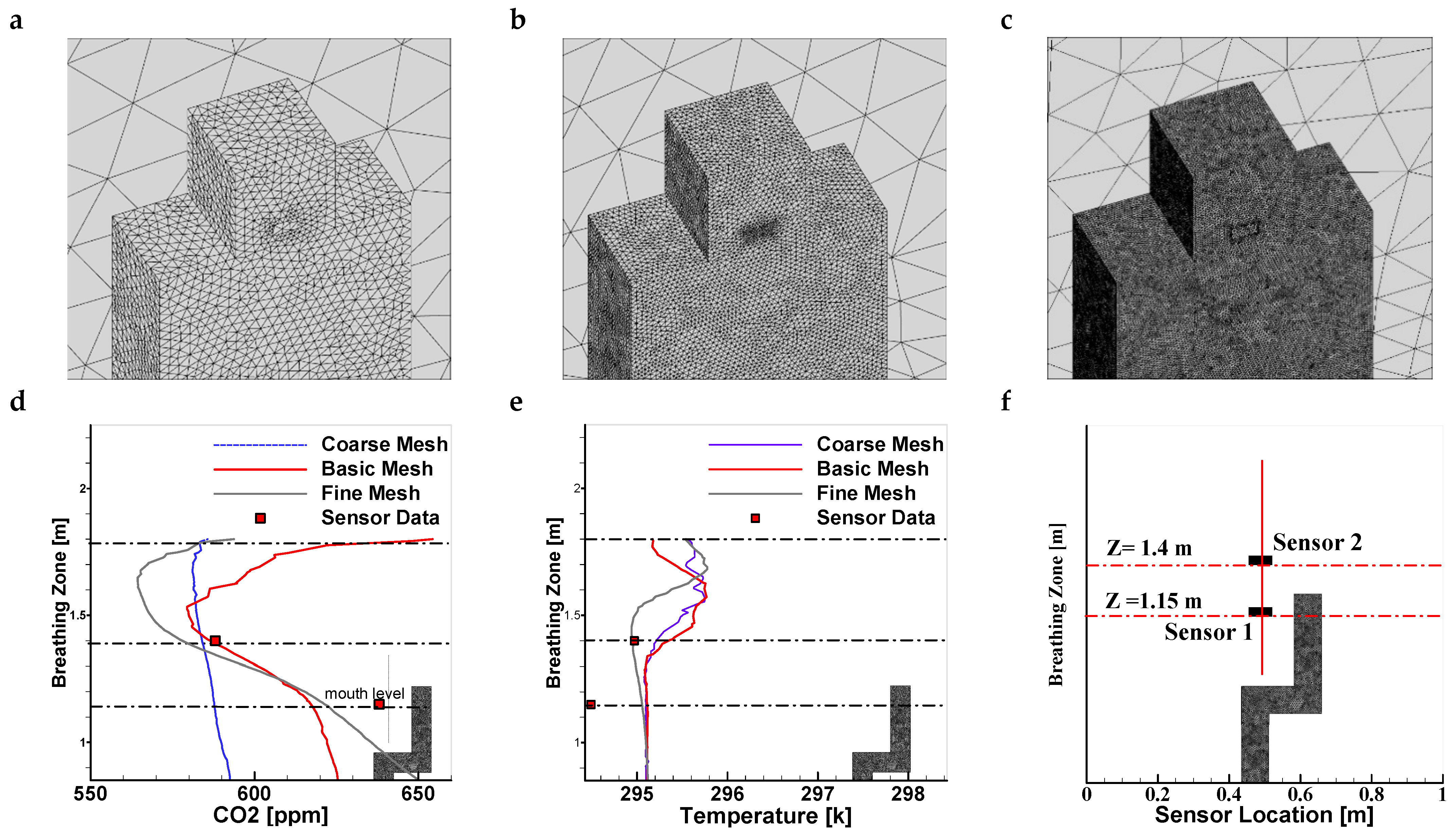


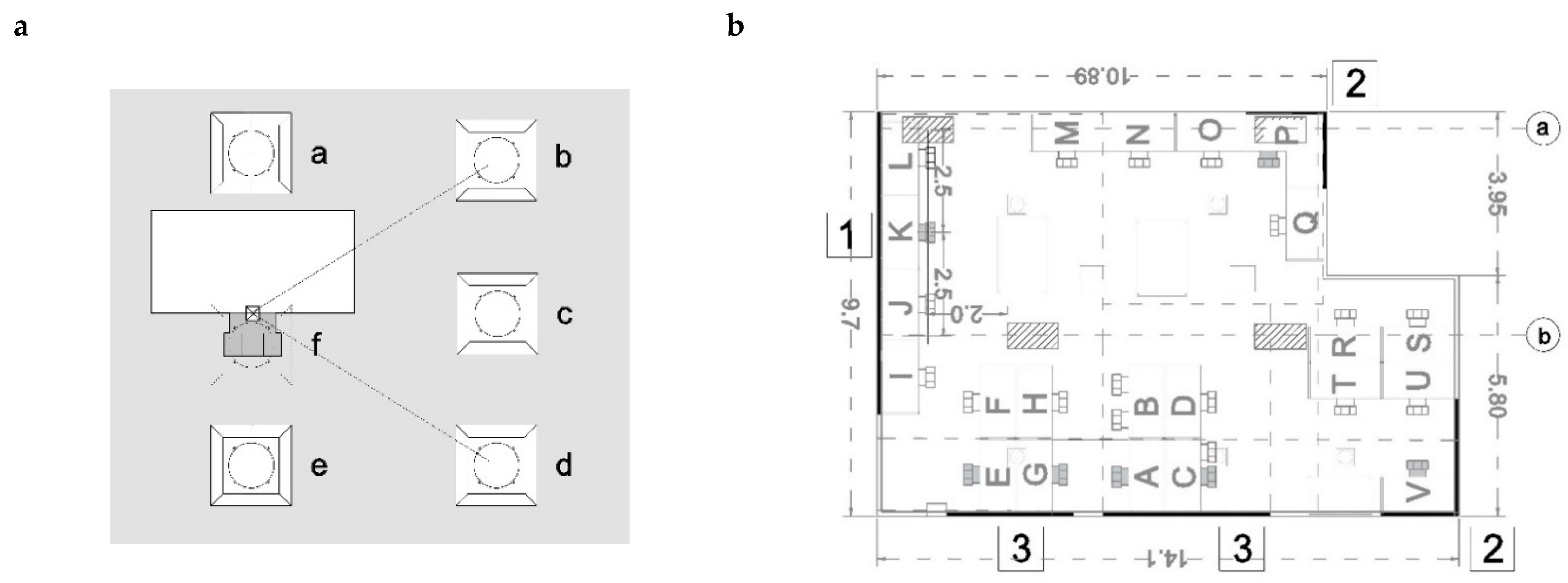
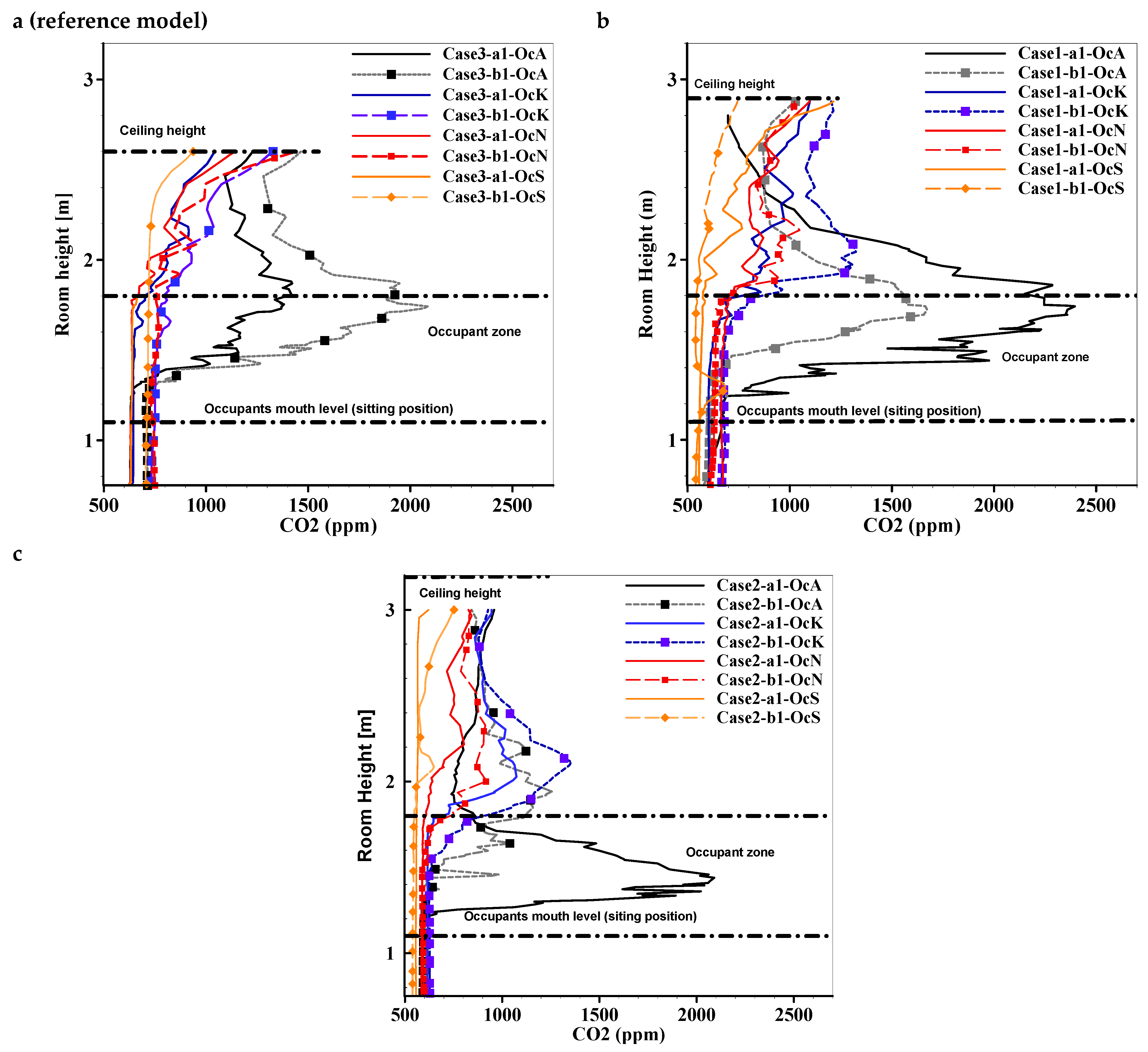

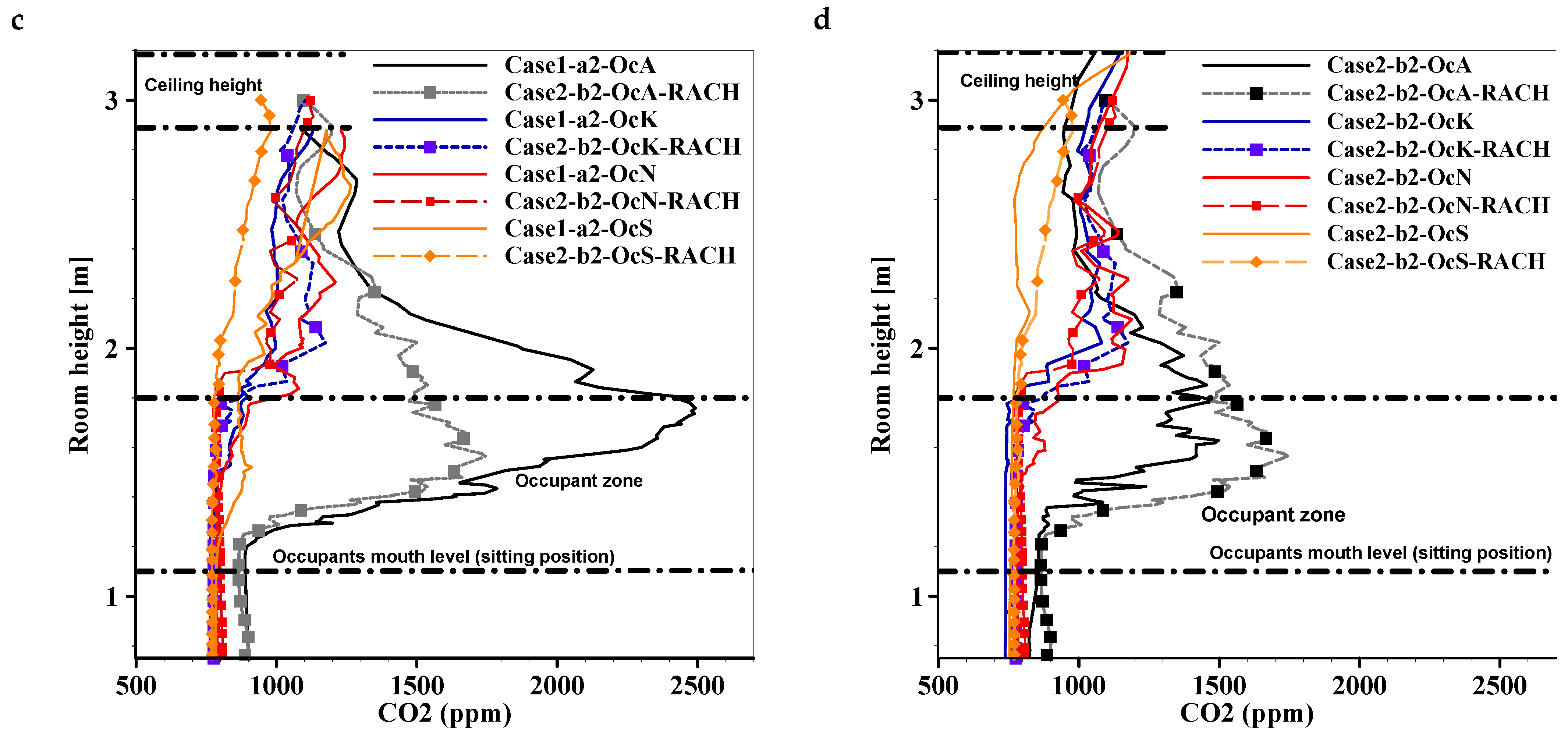
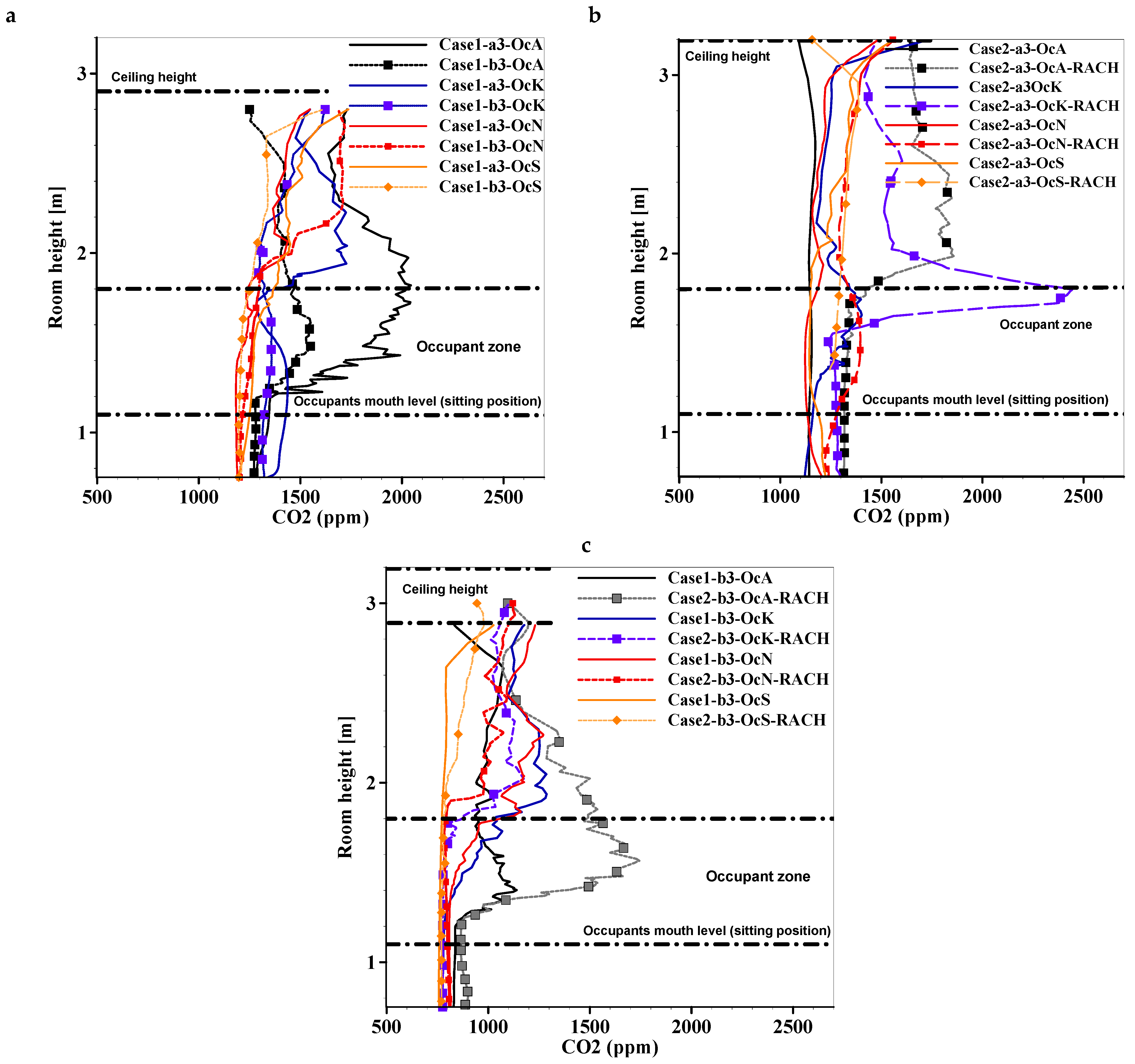




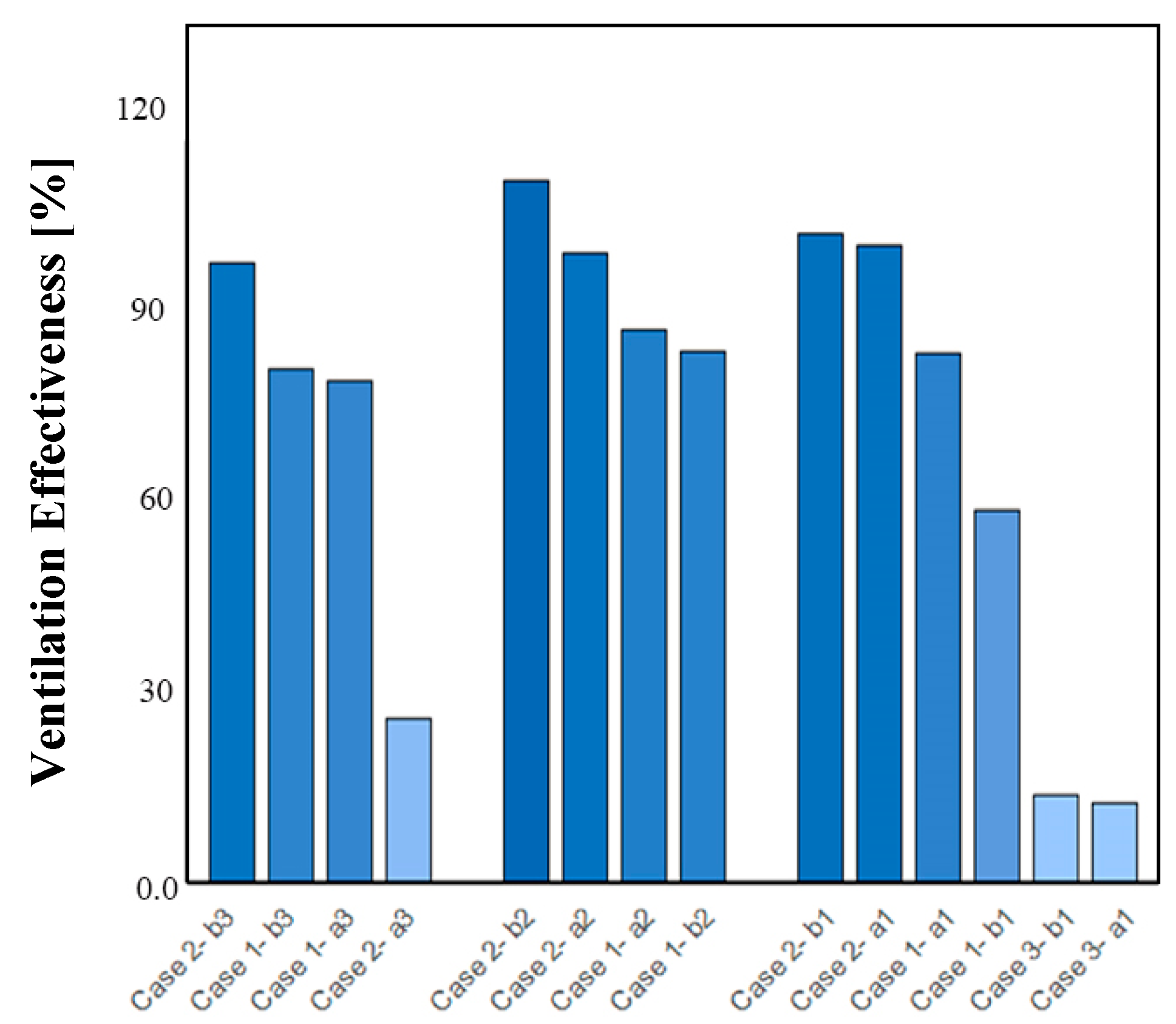
| Diffusers | Supply 1 | Supply 2 | Supply 3 | Supply 4 | Supply 5 | Total |
|---|---|---|---|---|---|---|
| Mass Flow Rate (kg/s) | 0.072 kg/s | 0.077 kg/s | 0.078 kg/s | 0.069 kg/s | 0.068 kg/s | 0.364 kg/s (0.311 m3/s) |
| Air change rate | 3.06 |
| Model | Sensor | Specification |
|---|---|---|
| HOBO (MX1104) (Onset Computer, Bourne, MA, USA) | Temperature | Temperature: Accuracy: ±0.20 °C from 0° to 50 °C, Resolution: 0.002 °C at 25 °C |
| HOBO CO2 logger (Onset Computer, Bourne, MA, USA) | Temperature | Temperature: Accuracy: ±0.21 °C from 0° to 50 °C, Resolution: 0.024 °C at 25 °C |
| CO2 | CO2: Accuracy: ±50 ppm ±5%, with the range of 0 to 5000 ppm, | |
| Airthings (Airthings, Oslo, Norway and Boston, MA, USA) | Temperature | Accuracy: 0.5 °C, Resolution 0.5 °C at 25 °C |
| CO2 | Accuracy: +/−30 ppm, Resolution: 0.005% | |
| Heat Stress Index/WBGT Datalogger-(HSDL300) (Triplett Test Equipment and Tools, Manchester, NH, USA) | Temperature | Accuracy: ±1.8°f /±0.6 °C, Resolution: 32 to 122 °F (from 0° to 50 °C) |
| TSI ALNOR Flow Hood (EBT731) (TSI Inc., Minneapolis, MN, USA) | Velocity | Velocity range: 0.125−12.5 m/s, Accuracy ±3% of reading at velocities >0.25 m/s, resolution 0.01 m/s |
| Mass Flow Rate | Mass flow rate: 25–2500 CFM, accuracy: ±3% of reading at flows >50 CFM, resolution 1 CFM | |
| Temperature | Temperature: accuracy ± 0.3 °C, resolution 0.1 °C |
| Boundaries | Conditions | Value | Unit |
|---|---|---|---|
| Floor | Temperature | 22 (295.15) | °C (K) |
| Vertical walls | Temperature | 22 (295.15) | °C (K) |
| Indoor materials | Temperature | 22 (295.15) | °C (K) |
| Ceiling | Temperature | 22 (295.15) | °C (K) |
| Manikin | Heat Flux [24] | 42 | w/m2 |
| Size of mouth | Area | 0.05 × 0.02 | m2 |
| Exhaust | Area | 0.6 × 0.8 | m2 |
| CO2 Source | Mass fraction of CO2 (ppm) | 463.3 | ppm |
| Lighting | Temperature | 23.35 (296.5) | °C (K) |
| Case Name | Exhaust | Room | No of | Ventilation | Air Change |
|---|---|---|---|---|---|
| Vent | Height | Occupants | Rate | Rate | |
| Location | (m) | (N) | (m3/s) | (h−1) | |
| Reference Case | a | 2.90 | 0 | 0.311 | 3.06 |
| Case 1-a1 | a | 2.90 | 4.0 | 0.311 | 3.06 |
| Case 1-b1 | b | 2.90 | 4.0 | 0.311 | 3.06 |
| Case 1-a2 | a | 2.90 | 10 | 0.311 | 3.06 |
| Case 1-b2 | b | 2.90 | 10 | 0.311 | 3.06 |
| Case 1-b3 | b | 2.90 | 24 | 0.311 | 3.06 |
| Case 1-a3 | a | 2.90 | 24 | 0.311 | 3.06 |
| Case 2-a3 | a | 3.20 | 24 | 0.339 | 3.06 |
| Case 2-b3 | b | 3.20 | 24 | 0.339 | 3.06 |
| Case 2-b3-RACH | b | 3.20 | 24 | 0.311 | 2.80 |
| Case 2-b2-RACH | b | 3.20 | 10 | 0.311 | 2.80 |
| Case 2-a2-RACH | a | 3.20 | 10 | 0.311 | 2.80 |
| Case 2-a1-RACH | a | 3.20 | 4.0 | 0.311 | 2.80 |
| Case 2-b1-RACH | b | 3.20 | 4.0 | 0.311 | 2.80 |
| Case 3-a1 | a | 2.60 | 4.0 | 0.258 | 3.06 |
| Case3-b1 | b | 2.60 | 4.0 | 0.258 | 3.06 |
| Case 2-a2 | a | 3.20 | 10 | 0.339 | 3.06 |
| Occupant | Arrangement | CO2 at BZ (ppm) | Occupant | Arrangement | CO2 at BZ (ppm) | Distance to Supply (m) | Distance to Exhaust (m) |
|---|---|---|---|---|---|---|---|
| D | ‘c’ | 1205 | T | ‘e’ | 1260 | X = 1, Y = 0 | X = 1.2, Y = 1.6 |
| M | ‘d’ | 1268 | P | ‘d’ | 1384 | X = 0.9, Y = 1.1 | X = 3.8 m |
| B | ‘b’ | 1347 | I | ‘d’ | 1701 | X = 2 (1.7), Y = 1.6 | X = 0, Y = 1.7 |
| A | ‘a’ | 1377 | K | ‘e’ | 1361 | X = 2, Y = 0.5 | X = 3.2, Y = 1.5 |
| E | ‘a’ | 1419 | O | ‘e’ | 1247 | X = 0.9, Y = 0.2 | Y = 4, (3.8) |
| The Average CO2 Concentration at BZ for Occupant A | CO2 Concentration at Exhaust 1 (ppm) | CO2 Concentration at Exhaust 2 (ppm) | |
|---|---|---|---|
| Case 1-a1 | 773 | 1270 | 1290 |
| Case 1-b1 | 864 | 600 | 570 |
| Case 1-a2 | 1027 | 770 | 810 |
| Case 1-b2 | 1082 | 780 | 800 |
| Case 1-b3 | 1377 | 1270 | 1290 |
| Case 1-a3 | 1554 | 1271 | 1294 |
| Case 2-a3 | 1148 | 1710 | 1690 |
| Case2-a3-RACH | 1327 | 618 | 651 |
| Case 2-b3-RACH | 1106 | 1283 | 1280 |
| Case 2-b2 | 741 | 767 | 847 |
| Case 2-b2-RACH | 1104 | 760 | 830 |
| Case 2-a2 | 1103 | 773 | 817 |
| Case 2-b1-RACH | 590 | 610 | 550 |
| Case 2-a1-RACH | 1290 | 590 | 590 |
| Case 3-a1 | 784 | 770 | 690 |
| Case 3-b1 | 969 | 730 | 730 |
| Zone | Occupants | Location in Relation to Air Supply | Average Distance to Supply (m) |
|---|---|---|---|
| Zone 1 | E, F, G, H, I | a, a, b, b, d | 1.34 |
| Zone 2 | J, K, L, M | d, d, e, d | 2.2 |
| Zone 3 | N, O, P, Q | d, e, d, d | 1.4 |
| Zone 4 | R, S, T, U, V | a, b, e, d, c | 2.19 |
| Zone 5 | A, B, C, D | a, b, f, c | 1.33 |
Disclaimer/Publisher’s Note: The statements, opinions and data contained in all publications are solely those of the individual author(s) and contributor(s) and not of MDPI and/or the editor(s). MDPI and/or the editor(s) disclaim responsibility for any injury to people or property resulting from any ideas, methods, instructions or products referred to in the content. |
© 2025 by the authors. Licensee MDPI, Basel, Switzerland. This article is an open access article distributed under the terms and conditions of the Creative Commons Attribution (CC BY) license (https://creativecommons.org/licenses/by/4.0/).
Share and Cite
Lesan, M.; Chahardoli, S.; Bhattacharya, A. The Synergy of Ventilation System Layouts and Occupant Arrangements on Ventilation Effectiveness: A Case Study in a Shared Office. Buildings 2025, 15, 3914. https://doi.org/10.3390/buildings15213914
Lesan M, Chahardoli S, Bhattacharya A. The Synergy of Ventilation System Layouts and Occupant Arrangements on Ventilation Effectiveness: A Case Study in a Shared Office. Buildings. 2025; 15(21):3914. https://doi.org/10.3390/buildings15213914
Chicago/Turabian StyleLesan, Mina, Saeid Chahardoli, and Arup Bhattacharya. 2025. "The Synergy of Ventilation System Layouts and Occupant Arrangements on Ventilation Effectiveness: A Case Study in a Shared Office" Buildings 15, no. 21: 3914. https://doi.org/10.3390/buildings15213914
APA StyleLesan, M., Chahardoli, S., & Bhattacharya, A. (2025). The Synergy of Ventilation System Layouts and Occupant Arrangements on Ventilation Effectiveness: A Case Study in a Shared Office. Buildings, 15(21), 3914. https://doi.org/10.3390/buildings15213914






